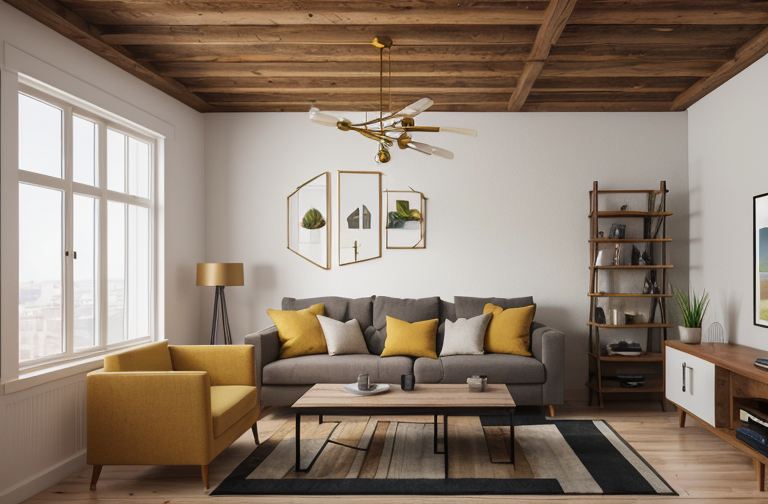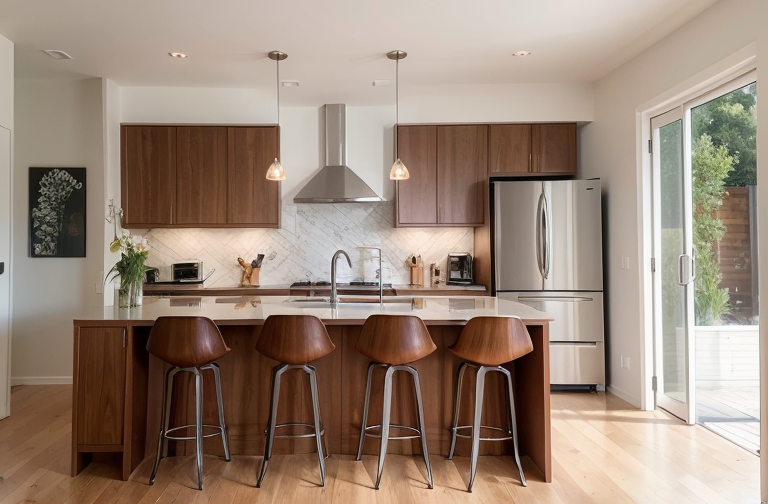Exploring the Charm of Modern Colonial Home Design: Key Characteristics and Design Elements

Explore modern colonial home design featuring traditional furniture shapes, layered moulding, mid-tone paints & scenic murals. Incorporate trim work, warm wood tones, and unique tiles.
Overview of Modern Colonial Home Design
Encapsulating a unique blend of time honored tradition and modern convenience, the resurgence of colonial house interior design ideas has sparked an exciting evolution in the world of home design.
Definition of Modern Colonial Home Design
Characterized by a juxtaposition of the old and the new, the Modern Colonial Home Design is a refreshing adaptation of the stately and symmetrical aesthetics of traditional colonial homes. While honoring the rich architectural heritage, this design style incorporates contemporary elements to create homely spaces that are both visually stunning and functional.
Historical and Traditional Influence
Colonial architecture, with its roots steeped in history, significantly informs this modern design movement. A hallmark of the of past eras, the classic colonial home evokes thoughts of grandeur, symmetry, and harmony. By contemporizing these historic and traditional forms, we breathe new life into them, creating designs that pay homage to their origins while perfectly fitting in today’s context.
Simplicity and Use of Local Materials
What sets modern colonial design apart from others is its nod to simplicity and its ingenious use of local, sustainable materials. Shunning the extravagances of ornate design, this style leans towards minimalist trends, allowing the beauty of locally sourced materials to take center stage. The result? Spaces that resonate warmth, sophistication, and a deeply ingrained sense of locality.
As an ardent lover of design movements, the evolution of modern colonial home design and its growing attraction has me thrilled. Marrying the elegance of the past with the necessities of the present, this design style truly encapsulates the essence of interior design.

Design Components of Modern Colonial Home
As an interior designer, I’ve come to cherish the style and substance of the modern colonial house interior design. Let me take you on a tour through the enchanting elements that make up this unique aesthetic.
Furniture Shapes and Accessories
Travel back in history a bit, and you’ll find traditional furniture shapes and accessory choices at the heart of colonial homes. The graceful lines of Hepplewhite and Sheraton style furniture punctuate spaces with their classic charm. Wedgwood style china and silhouette art add layers of authentic character. But while such elements are undeniably captivating, there’s more to explore in these elegant dwellings.
Role of Moulding and Trim Work
Each element tells a story in a colonial home. The layered moulding work, the intricate trim work they all speak volumes about the history and craftsmanship of the era. The mouldings create frames, outlining the architectural beauty of the home, while trim work adds the finishing touches on doorways and windows—each piece a silent narrator in our design journey, sharing tales of yesteryears.
Color Schemes and Lighting Choices
A glance at a modern colonial home reveals a preference for neutral or mid tone paint colors. The soft hues exude an air of timeless elegance while allowing furniture and decor items to take center stage. However, it’s the impact of lighting that truly gives life to these spaces. The glow from antique brass chandeliers casts a warm, welcoming ambiance, enveloping each room in a rich layer of cozy illumination. It’s a symphony of light and color that hits the perfect note every time.
And there you have it the jigsaw puzzle pieces that, when assembled, shape the breathtaking panorama of a modern colonial home. Each component contributes to weaving a narrative that is as charming as it is enduring.

Material Considerations in Modern Colonial Home Design
My particular interest in colonial style house interior design provokes a special focus on choosing the right materials. This choice is not only essential in embracing tradition but also in reintroducing a sense of authenticity in our living spaces.
Wall Features: Murals and Paints
Wall features in modern colonial designs often take on a dual role of making a statement while subtly blending tradition with modern aesthetics. I like to think of murals as silent narratives that add historical and artistic depth to a space. A touch of paint can impart your personality on the blank canvas of your walls, influencing the mood and ambience. Opt for hushed, earthy hues or decisive strokes of bold colors to mirror your persona or embrace the tranquility only an aesthetically pleasing space can provide.
Wood Tones Choice
Wood speaks a language of its own in colonial designs. A warmer wood tone can infuse a space with a sense of nostalgia and whisper stories of a bygone era. I often lean towards richer tones as they effortlessly harmonize with the overall traditional aesthetic. Oak, mahogany, and walnut, typically used in colonial times, can be exciting elements to integrate into your space, giving it a genuine, classic allure.
Tile Experimentation
Tiles in a colonial style home add character and versatility to the interior design. I see them as an opportunity to experiment not just in your bathrooms but in various spaces of your home. Consider a monochromatic palette or maybe detailed patterns and motifs. Whether you go down the classic route with terracotta or venture into the modern trend of graphic tiles, it’s your canvas – paint your story.
Remember, the essence of colonial design lies not just in its aesthetics, but in recounting a piece of history, transferring it through the language of design into the heart of your home. Happy designing!

Regional Adaptations in Modern Colonial Home Design
As an aficionado of interior design, I’ve always found it fascinating how regional settings can greatly influence the look of a modern colonial home. The environmental aspects of the locality come into play, shaping the aesthetics while paying homage to the past. For instance, in New England, where the chill of the winters is legendary, modern colonial homes may have lower roofs to preserve heat, evocative of the 1980s house interior design ethos.
Influences of Regional Settings
Each region has a specific character that significantly influences the design elements of modern colonial homes. The stones, soil color, foliage, and surrounding bodies of water all become a source of inspiration, molding the form, color schemes, and materials of the structure itself. Think red roofs in the South, or grand colonial porches in the humid climates of the East Coast. 😊
Impact of Regional Preferences on Design Elements
Regional preferences, of course, mingle with these natural influences to create a culturally authentic home design. After all, form and function must dance in perfect harmony, right? This harmony can be seen in the adaptations made to blend the past and the present, creating homes that are beautiful and practical.
Symmetrical Arrangement of Doors and Windows
Speaking of harmony, one thing is commonly observed in colonial homes: the symmetrical arrangement of doors and windows. This is not only an aesthetic choice but also a nod to the historic architectural traditions a way of preserving and celebrating the past while meeting modern needs. The balance offered by this symmetry exudes an elegant simplicity, regardless of the region.
So yes, modern colonial homes may adapt to their geographical surroundings and cultural preferences, but they maintain a consistency in embracing their past and shaping it to mold the present. It’s a balancing act of respecting tradition while weaving in innovation.
Key Takeaways
As we usher out the ebullient textures of the 1980s house interior design era, our journey brought us back to the historic motifs of colonial house interior design ideas. Paying homage to our historical roots, while concurrently infusing contemporary flair is the cornerstone of modern colonial house interior design. You can’t separate our past from our present; they are indelibly intertwined. Bringing historical traditions into modern design doesn’t merely add a layer of aesthetic charm, it resonates with our cultural values and paints a poignant narrative of evolution.
Importance of Historical Traditions in Modern Designs
These design practices are about far more than just robust wooden beams and plastered walls. They bring history back to life, unfolding tales of bygone eras while striking a balance with contemporary sensibilities. For me, infusing historical traditions in colonial style house interior design is like preserving pieces of our past in a living museum. Not to cage them, but to celebrate them in their full glory.
Essential Design Components in Modern Colonial Homes
A modern colonial home isn’t complete without a distinct narrative reflected in its design elements. From symmetrical facades to ornamental molding, wide plank wood floors to multi pane windows, these homes seamlessly blend modern functionality with deep rooted aesthetics. This fusion of old and new gives their architecture a unique charm, speaking to the hearts of inhabitants and admirers alike.
Regional Adaptations in Modern Colonial Home Designs
Lastly, let’s address the profound influence of regional adaptations in modern colonial home designs. These homes reflect the history, climate, and culture of their local environment, magnifying their allure and charm. From Cape Cod to Antebellum, Spanish to Dutch, each regional style carries a distinct personality that continues to evolve alongside the modern design landscape.
In essence, the marriage of historical traditions with modern designs is more than an aesthetic choice. It represents a respect for our past and a celebration of design evolution. To walk through a modern colonial home is to traverse through time, exploring elements of heritage cleverly bound with contemporary accents. It’s a magical design journey – one that engrains a sense of belonging while opening the doors to innovative creativity.
- Unlocking the Intricacies of Interior Design: Ranch-Style Homes and the Pursuit of Functionality
- Blending Tradition and Modernity: Exploring the Design of Nipa Hut and Trynagoal Tea House
- Enhancing Dining Experiences through Creative Interior Design and Rebranding in Burger Restaurants
- Mastering Home Renovation: The Crucial Roles of an Interior Designer and Effective Budget Management
- Understanding the Value of Interior Designers: Roles, Benefits, and Selection Process
- Exploring the Richness of Turkish Architecture and Interior Design through Adobe Stock and Pinterest
- Unveiling the Unique Characteristics and Design Elements of Ranch-Style Houses
- Embracing Openness and Personal Touch: The California Ranch House Interior Design Concept
- Embracing Warm Minimalism: The Rise of Brown Tones in Interior Design
- Enhancing Your New Home: Key Elements and Strategies in Interior Design
- Unveiling the Art of Luxury Interior Design: Exploration of Materials, Individual Style and Inspiration from Pinterest
- 13 Easy and Affordable Tips to Spruce Up Your Home Decor
- Exploring the Rich History and Distinctive Features of Tudor Architecture
- Exploring British Home Interiors: From Historical Evolution to Modern Adaptation
- Traversing the World of Interior Design: From Designer Profiles to DIY Ideas and Future-ready Furniture
- Contemporary Home Refinement: Leveraging Exposed Brick Design and Affordable, High-Quality Furnishings
- Exploring the Warmth and Charm of Modern Rustic Interior Design
- Enhancing Duplex and Triplex Interiors: An In-Depth Guide to Style, Lighting, and Effective Use of Space
- Creating Your Dream Bathroom: A Comprehensive Guide to Designs, Functionality, and Material Selection
- Creating Your Personal Spa: Insights into Modern Bathroom Design Trends



